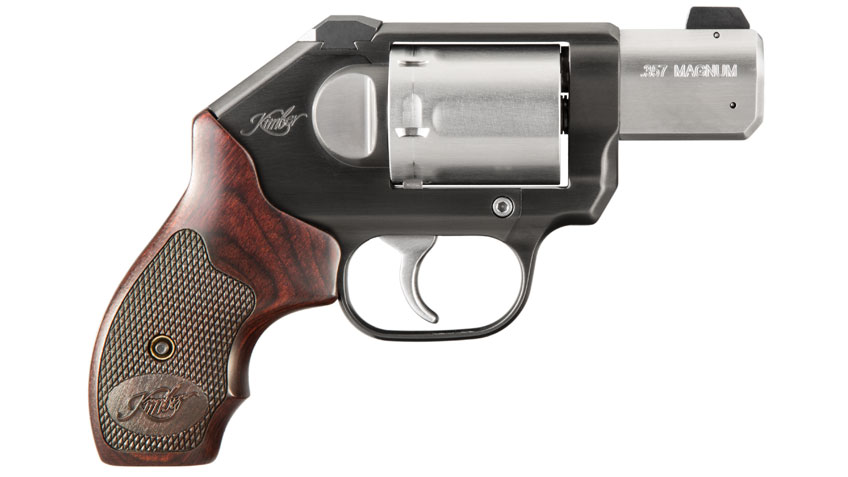
Kimber surprised most of us wheelgunners when the maker of high-quality 1911s and bolt-action rifles jumped into revolver manufacturing. Rather than focusing on the popular lightweight, snub-nose pocket-revolver market, the company brought out a six-shot .357 Mag.-caliber wheelgun called the K6s. Using stainless steel to build the revolver, the weight came in at 23 ounces, unloaded. Flattening the sides of the cylinder between chambers helped save some weight and lent an interesting overall look to the cylinder, but the half-pound weight increase definitely went against the trend. However, despite the upward growth in the specifications, Kimber maintained a focus on keeping the new K6s compact.
At 1.4 inches wide, Kimber claims the K6s (my test gun is the new Model CDP) is the narrowest six-shot revolver on the market. The round-butt frame keeps the K6s’ length to just over 6.5 inches and eliminates the “print” characteristic of revolvers with larger grip frames when carried under an outer garment. Serrations on the backstrap facilitate the shooter’s purchase without posing the threat of snagging a garment during presentation. The Model CDP has blackened rosewood grips with some nicely done checkering and the Kimber logo. Grip panels are wide in the middle and taper at both ends.
Despite having only room for two fingers around the frontstrap, the Kimber K6s CDP is extremely comfortable to hold. The 2-inch barrel is machined from a solid piece of steel; no sleeves or other cost-saving techniques to mar the impressive, trapezoidal shape of the barrel. The CDP is two-toned; the cylinder and barrel wear a brushed-stainless steel finish while the rest of the gun wears Kimber’s black diamond-like carbon coating that is applied over the stainless steel. It’s called a “DLC frame,” and the overall look is distinctive.

With its internal hammer, the K6s CDP can be fired only in double action. Kimber calls it a “non-stacking” trigger and sets trigger pull at the factory between 9.5 and 10.5 pounds. While that may sound heavy to some, it is as Kimber claims: non-stacking and very smooth. It also lends itself to “staging,” thus allowing some fairly precise shooting as the cylinder rotates into battery during the first 3/8 inch of trigger travel, then hesitates slightly prior to moving the final 1/8 inch. It isn’t quite as crisp as manually cocking a classic double-action revolver, but it’s close.
I have to give Kimber huge kudos on the dimensional design of the K6s’ sights. The pinned front sight is rather tall and wide for a snubby, and the blade contains a typical night sight insert, but with ample blue metal showing all around the insert. The dovetail-mounted rear sight contains a conventional two-dot night sight and has a notch wide enough and deep enough that a conventional sight picture is possible given adequate ambient light.
This means that during a close-range, sudden attack in dim lighting you have the rapid response of the night sights, but given a longer-range engagement during daylight hours, you have a crisper sight picture to make precise hits at greater distances. The larger rear-sight notch and front-sight blade are made possible by the wide channel machined out of the revolver’s topstrap. This wide channel and setscrew-anchored rear sight also allow for some windage adjustment, if needed. And finally, the angled base on the rear sight is serrated to reduce glare. These are capabilities and features not normally found on snubnose revolvers.

Both .38 Spl. self-defense loads I tested were controllable, which is not to say I’d enjoy going through several hundred rounds in a one-week class. My hands got a little sore from extended shooting, but that would not be an issue during more moderate practice and certainly not in personal protection situation. Relative to most small wheelguns when firing .38 Spl., the Kimber is comfortable.
However, the .357 Mag. loads are another matter. Shooting them became painful rather quickly, rendering any sort of extended practice session unpleasant. If it were my gun, I would round off the edge at the top of the rosewood grip panels where it contacts the thumb. You could also get a larger grip, but it might compromise concealability.
Given the improved performance of today’s .38 Spl. loads, I wouldn’t spend much time with .357 Mag. ammo on the practice range, but only you can judge your level of felt-recoil tolerance. Also, remember that all snubnose revolvers have a short-stroke ejector rod, meaning that neither .38 Spl. nor .357 Mag. cases completely exit their chambers when the ejector is at full stroke. However, the shorter .38 Spl. cases are more likely to fall clear.
Even if you are not interested in .357 Mag. ammo, you should still consider Kimber’s K6s. It’s well made and that extra half pound of weight provided by all-steel components dampens felt recoil on good .38 Spl. defensive loads, keeping you on target when you aim to protect yourself.





































